Ardent analyses of Castlevania, Souls, Bloodborne, and architecture
Don't wanna be here? Send us removal request.
Text
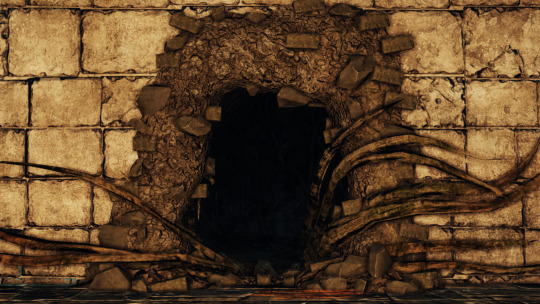
Something that I've been anticipating lately is a renewed appreciation for FromSoftware's post-King's Field "medievalist" releases which de-emphasize speed and spectacle; that is, Demon's Souls, Dark Souls, and Dark Souls 2.
I'm a little surprised that there hasn't been much commentary on the gradually diverging artistic shift we can track from Demon's Souls to Elden Ring. Mostly, the discursive possibilities have been limited to remarking upon whether or not Elden Ring is "too hard" relative to some earlier title. This focus on design has tended to occlude observations on the aesthetic consequences of a divergence.
In a variety of ways, Elden Ring is not only (in an abstract, although probably very often also in an actual, sense) a much harder game than Demon's Souls; it also represents something of the upper limit of a type of grandiosity of combative expression, whether that has to do with a boss' design or the capabilities of our avatar. Were we to be dismissive, and maybe a little culturally reductive, we could use the term "anime" for critical shorthand when describing how one of Shadow of the Erdtree's bosses has a magical sword attack that encompasses the entire space of a fairly large arena.
On the one hand, Elden Ring represents a sensible evolutionary point of a mechanical foundation established by Demon's Souls. On the other hand, Rellana's courtyard-sweeping attack, and other things, like very nearly anything to do with the second phase of the DLC's final boss, are the sort of stuff I joked about as an inevitability after finishing Dark Souls 3's DLC. Pretty much any major opponent from Dark Souls and its sequel seems like a quaint, jerky windup toy when compared to Elden Ring's bosses.
I wonder, though, if that relative restrictiveness won't come to be newly valued for the differentiation it represents internally to these games -- perhaps most visibly with Dark Souls 2, which not too soon after its release, and ever since, has tended to be spoken of as an outcast in need of either a dunking or a defense, or has confused people obsessed with ranking their media diet. It's highly unusual that Dark Souls 2's development team would decide to make a game which is more slow and methodical than its two forebears. This is a very uncommon progression -- so uncommon that a lot of people would, I am sure, consider it to be a regression. But, perhaps, we now have an opportunity to see this slowness with different eyes.
In a previous post, I wrote, of Shadow of the Erdtree:
There’s a lot of good level design to be found here among the dungeons, castles, and forts, yet the abundance and enormity of it all seems to have deprived the game of significant contrasts, and those special spatial moments, which I found much easier to locate and reflect upon with, say, Dark Souls or Bloodborne. Sure, the sky-piercing spiral of Enir-Ilim is a sight to behold; but soon enough the sequences of grand staircase upon grand staircase, great bridge upon great bridge, creates a perpetual climatic grandiosity that diminishes the very effect of a climax.
This "climax fatigue" is similarly applicable to Elden Ring's weapons, a good number of which have some dramatic, slick, or acrobatically superhuman secondary function. Whereas Dark Souls has almost no obviously "cool" weapons, most being within a range of utilitarian swords, maces, clubs, and spears, Elden Ring has so many superlative offensive items and skills that, after a while, these flourishes become lost among a fantastical morass of melodramatic aesthetics. And whereas Demon's Souls is undeniably much simpler when compared to Elden Ring, there is something satisfying about the older, "inelegant" design where you can feel the proximity to the dungeon crawler sensibility: blunt, rough, and chunky.
The recently unveiled Nightreign would appear to represent one kind of developmental compartmentalization at FromSoftware between more frequently released offshoots and principle works with longer developmental cycles. I'm curious if it might not also represent a forthcoming differentiation between the faster, more spectacular type of gameplay and a slower, less flashy type of gameplay which may be calling back to Miyazaki after years of an intensifying emphasis on the big and bold "anime" side of things.
21 notes
·
View notes
Text

Here's a piece I finished a few months ago, entitled Panoply. Ink pens and just a little bit of watercolor on paper. As usual, I feel much better about my handling of linework than my handling of color. This is getting a little closer to the more primitive and mysterious aspects of temple architecture. The genitalia on either side are a reference to the hermai sculptures of antiquity, while the face at the top is a variant of the Green Man trope.
16 notes
·
View notes
Text

Hey, everyone. I just published the first long-form piece on anything to do with the Castlevania series I've written in some years. You can read it here, on my Substack page. The conclusion is, I admit, a little similar to the one I appended to a compilation of prior essays on Castlevania: Curse of Darkness -- but I suppose that's just where my head has been lately. Old, imperfect things and time's passage.
15 notes
·
View notes
Text

Hey, everyone. I just published the first long-form piece on anything to do with the Castlevania series I've written in some years. You can read it here, on my Substack page. The conclusion is, I admit, a little similar to the one I appended to a compilation of prior essays on Castlevania: Curse of Darkness -- but I suppose that's just where my head has been lately. Old, imperfect things and time's passage.
#castlevania#metroidvanias#symphony of the night#aria of sorrow#harmony of dissonance#circle of the moon#dawn of sorrow#portrait of ruin#order of ecclesia#akumajou dracula#videogame criticism
15 notes
·
View notes
Text

Here's a piece I finished a few months ago, entitled Panoply. Ink pens and just a little bit of watercolor on paper. As usual, I feel much better about my handling of linework than my handling of color. This is getting a little closer to the more primitive and mysterious aspects of temple architecture. The genitalia on either side are a reference to the hermai sculptures of antiquity, while the face at the top is a variant of the Green Man trope.
16 notes
·
View notes
Text








Just a few edits I'd made of screenshots from Castlevania: Harmony of Dissonance, and which I found lying around in a folder.
#castlevania#akumajou dracula#harmony of dissonance#metroidvania#igavania#juste belmont#gba#konami#dracula
31 notes
·
View notes
Text


Hi, everyone.
I've republished two of my pieces on Substack, in addition to supplementing one. The first, "The Soul of Place", was originally published on the now-defunct website No Escape. I was compelled to repost it both for the purpose of preservation and because its subject matter was brought to mind for me when viewing the videos of YouTube user Any Austin, who has a variety of uploads granularly exploring videogame sites.
The second, "Castlevania: Curse of Darkness; or: It’s Just Like Symphony of the Night, Except Not At All!", compiles and edits a four-part series of posts from here and adds another section to the end. I suppose seasonality is what directed me to focus upon something Castlevania, even if it's a reprise.
Thanks for reading!
6 notes
·
View notes
Text


Hey, everyone. In case you are unacquainted with it or missed these publications -- and I know the topics are not those on which I've built most of my reading audience -- I have two relatively new essays available to read on my Substack page. The one is a fairly dense exploration of the presence and role of counter-intelligence within the UFO mythos; the other is a more free form walk through the aspects and implications of persistent, melancholic dream spaces.
7 notes
·
View notes
Text




Just a few edits I'd made of screenshots from Castlevania: Harmony of Dissonance, and which I found lying around in a folder.
31 notes
·
View notes
Text


Hi, everyone.
I've republished two of my pieces on Substack, in addition to supplementing one. The first, "The Soul of Place", was originally published on the website No Escape. I was compelled to repost it because its subject matter was brought to mind for me when viewing the videos of YouTube user Any Austin, who has a variety of uploads granularly exploring videogame sites.
The second, "Castlevania: Curse of Darkness; or: It’s Just Like Symphony of the Night, Except Not At All!", compiles and edits a four-part series of posts from here and adds another section to the end. I suppose seasonality is what directed me to focus upon something Castlevania, even if it's a reprise.
Thanks for reading!
6 notes
·
View notes
Text


Hey, everyone. In case you are unacquainted with it or missed these publications -- and I know the topics are not those on which I've built most of my reading audience -- I have two relatively new essays available to read on my Substack page. The one is a fairly dense exploration of the presence and role of counter-intelligence within the UFO mythos; the other is a more free form walk through the aspects and implications of persistent, melancholic dream spaces.
7 notes
·
View notes
Text

I seem to be in the spirit of dunking on the most irritating contingent of the so-called Souls community (i.e., "Souls veterans"). Yesterday, I did a YouTube search for Dark Souls 2, and these are the first results I got. Guys: this is crazy. Dark Souls 2 has been stuck in a discursive loop for a literal full decade and it pretty much all has to do with Matthewmatosis putting out a critique within the first month or two of the game's release. No long-form analysis since has been able or willing to escape the vortex of "Is it GOOD or NOT GOOD (relative to Dark Souls, my Favorite Game of All of the Times)???" We just keep getting hours-long meandering "hot takes" about how it's either "better" or "worse" than some collective mentality thinks it is.
This pseudo-critical loop has been on my mind because what is also the most irritating vocal contingent of Elden Ring's playerbase has been doing nothing except recycling the half-assed observations deriving from Joseph Anderson's equally premature word-vomit. I've been looking through various videos having to do with certain bosses for Elden Ring's DLC, and one of the most persistent comments is "lmao trash boss with nearly unavoidable attacks." Sorry, guys: there is no such thing as "nearly unavoidable"; either the attack is avoidable, or it isn't, and it's up to you to clear the gap if it is. And this was the whole thing about Anderson's critique -- framing the game in a way that was coming from the perspective of someone who's mad that they can't do exactly what they did against Ornstein and Smough to first-time a brand new boss, and, instead of trying to figure out what's happening, decides that the game is exclusively for a new class of Übermensch.

I dunno, man. I'm tired of this framework for new media criticism: bloated, disorganized videos responding to the item in question as soon as it hits, and petrifying the general interpretative mentality of the people doing most of the opining, because a majority of the audience is just waiting for an authority figure to make up their mind for them in a way that's convenient to their prejudices. Folks nowadays might rightly wonder what import or responsibility the critic has to play anymore; but I'd say that these videos are excellent examples of fairly powerful criticism which has been exceeding textual norms for a while, and has been poisoning various wells in a way that mostly can't be dealt with because of the convoluted format and the exceptional power of group-think on online spaces.
40 notes
·
View notes
Text
Hi, everyone. I just released a new album on Bandcamp.
ARRANGEMENTS is a curated album of arrangements written over the course of about fourteen years. To me, it seems impossible to conceive of a composer who was not compelled to begin their creative journey through the work of others; so I see this album as, on the one hand, a tribute to certain composers whom I admire, with Hitoshi Sakimoto finding the greatest representation among the group. On the other hand, I think this album demonstrates the scope of what's taken my fancy, leading me to spontaneously rework pieces which otherwise don't occupy much of my mental space -- such as the theme music for the YouTube channel MemeAnalysis, or a song from The Little Mermaid. Some tracks have been modified to sound a little more dynamic or balanced in their mixing, but in most cases the pieces have remained untouched since their compositional completion. The tracklist is roughly organized according to a chronological order.
Credits: Anonymous, Johann Sebastian Bach, Gabriel Eduardo, Masashi Hamauzu, Andrew Hewitt, Yasuhiro Ichihashi, Kenji Ito, Richard Jacques, Jana Kurta, Alan Menken, Hitoshi Sakimoto, Nobuo Uematsu, Yasuhisa Watanabe, Michiru Yamane
#vgm#vg music#vgm remix#vgm cover#video game music#digital fusion#little mermaid#castlevania#hitoshi sakimoto#nobuo uematsu#windows96#js bach#kenji ito#richard jacques#masashi hamauzu#Bandcamp
10 notes
·
View notes
Text
Something so perfectly, humorously irritating about the neat resonance between the theme of cycles and the occlusion of history in FromSoftware's games and the perpetual pattern in the playerbase of people who deem each new game or its DLC as "impossible", "unfair", a "betrayal of core principles", always forgetting that this is exactly how they behaved the last time.
61 notes
·
View notes
Text

For one of my recent exhibitions, a friend helped me build a bunch of frames, and he asked that I do a piece for him in return. I went for something similar to the colorful work I was making during the later months of last year, drawing on a mixture of shingle style and farm buildings. The linework was done using a bunch of different ink pens, and most of the color comes from watercolor paints. In my head, I had the image of a building which appeared to progress from a summery to an autumnal palette, as if the building were alive and getting ready for fall alongside the surrounding plant life.
#architecture#shingle style#farm#barn#architectural drawing#architectural painting#fantasy architecture#imaginary architecture#capriccio#organic architecture
11 notes
·
View notes
Text
Shadow of the Erdtree: Some Reflections
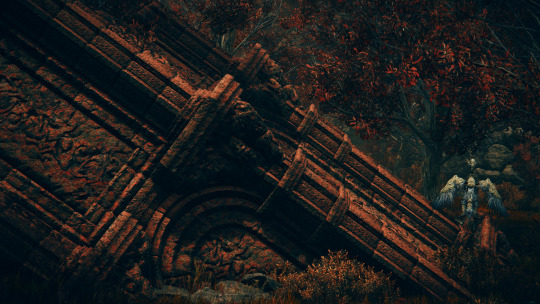

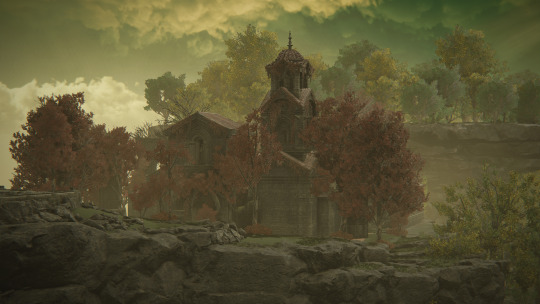

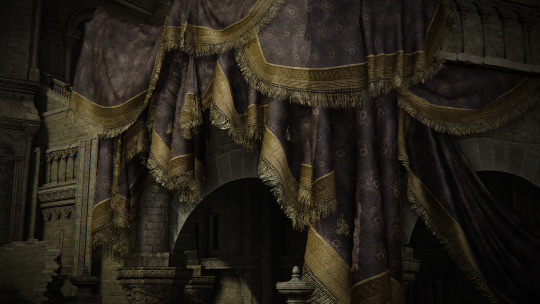
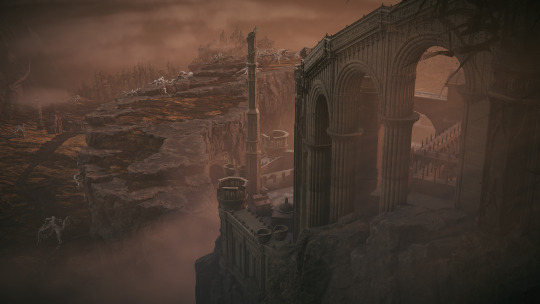
Well, folks, since no one asked, here are some thoughts I've had while exploring Elden Ring's add-on, Shadow of the Erdtree.
The existence of an alternate shadow realm has solidified my conviction that what Elden Ring is depicting on micro and macro scales is the phenomenology of etheric bodies -- extending even to the moon, the double of which is visible from the Moonlight Altar plateau (this is reflected by Rellana's Twin Moons spell). Each of these bodies possess a regulating function. Although each might be generally described as doppelgänger, the occult scientist Rudolf Steiner wrote of the Doppelgänger proper as its own sort of body, responsible for the tension between aspiration and temptation. It's interesting to me that this is such a major preoccupation of the game, because it indicates a layer of esoteric involvement, on the part of Elden Ring's narrative conceptualizations, that I don't think anyone in the so-called lore community has picked up on yet. The shadow realm helps explicate the otherwise inexplicable Godefroy the Grafted, too.
Various details have also strengthened my impression that the revolt against Nature we see in Elden Ring is a revolt against motility -- motility being the ultimate enemy of utopia: a human conceptualization reliant upon infinite stasis. In the base game, I think we see this revolt most profoundly in the narrative of Ranni, who first abandons her own flesh and then strives towards the realization of an Age of Stars, that "thousand year voyage under the wisdom of the Moon." Although the Seedbed Curse represents its own revolt against Nature, it remains within the organic order. Ranni's vision is of the inorganic and remote. And I don't think it's unrelated that, in certain esoteric cosmological systems, the moon stands as most distant from the Absolute.
The colors of the landscapes and sky are amazing: vivid, autumnal, and strange. These palettes have only made me dislike the game's rain effect all the more, which does not deepen the arboreal colors (as it should) but drains all surfaces of color and sets them into a depressing, bland grayscale. To say that the rain is a part of why I consider Raya Lucaria to be Elden Ring's low-point in the realm of major level design could be seen as a trivial complaint, but visual drudgery will wreck even the best schemes; and Raya Lucaria is as far as you can get from that anyway. FromSoftware has done fine with types of snow (see, e.g., the Frigid Outskirts or Painted World of Ariandel), but I think they've yet to figure out rain, among some other graphical technicalities.
The forges are among my favorite instances of discrete level design, even if, or maybe because, they tend to contain only two or three enemy types, feature no bosses, and severely scale back the level of challenge. I happened upon one yesterday that I did find a little dull, but the other two were wonderful, brief, atmospheric knots, quiet sequences of colossal architecture, that sort of evoked shades of Stonefang Tunnel from Demon's Souls. On that note, I'd call special attention to the forges' theme music. The only other piece of music from the DLC that's gotten my attention is the theme for Belurat.
Plants are People, Too.
Torrent is just... a terrible inclusion for this game. It's maybe obvious enough to not warrant being said, but -- any design decision has to be evaluated on what it contributes to the system it's been set into, and Torrent adds nothing outside of the occasional, brainless convenience. I could maybe see an argument for Torrent's presence if he had some emotionally charged narrative integration, maybe like what Shadow of the Colossus did. Without this, Torrent is nothing but a tool which perpetually problematizes the overworld's scale (a bit too big, yet no fun to traverse at high speed) and trivializes all of its gauntlets on a potential and actual level far worse than anything the Spirit Ashes could ever do. Better to me would've been if the only way to use a mount were by defeating a mounted knight without killing their horse and then sneaking up to the runaway to gain ownership of it.
I'm finding the map much more engaging than that of the base game because of how it plays with abstractions and builds anticipation through that. One part of the map, for instance, shows a bunch of trees with red leaves. Reaching this place reveals these "trees" to be enormous red flowers. Another section shows pink, purple, and orange specks. What are these? And what are the gray, finger-like lumps erupting from the mass next to it? I've also found it tough to figure out how to progress from one plane to another because of how densely stacked and knobby the continent's features are, so consulting the map has been helpful in a way I rarely experienced with the base game's.
Love how much the Ancient Ruins of Rauh resemble The Elder Scrolls IV: Oblivion, from the explosion of verdure, to the crude, architectural naivety defining the pseudo-Gothic structures.
With Shadow of the Erdtree, I keep coming up against an unresolvable simultaneity like the one mentioned above regarding the overworld. There's a lot of good level design to be found here among the dungeons, castles, and forts, yet the abundance and enormity of it all seems to have deprived the game of significant contrasts, and those special spatial moments, which I found much easier to locate and reflect upon with, say, Dark Souls or Bloodborne. Sure, the sky-piercing spiral of Enir-Ilim is a sight to behold; but soon enough the sequences of grand staircase upon grand staircase, great bridge upon great bridge, creates a perpetual climatic grandiosity that diminishes the very effect of a climax (and I'm not even sure that Enir-Ilim is the DLC's intended final location). Anor Londo or the Nightmare of Mensis could feel special because the qualities and features of their spaces stood apart from everything else. Elden Ring, I think, has gotten itself into a predicament by trying to one-up its internal material and all prior FromSoftware games through the enormity of its scale -- and challenge. More and more, I've been craving a new project from them that resets these terms of engagement, even while enjoying the consistency of the material at hand.
That's all for now! In time maybe I'll turn these thoughts to an essay for my Substack page, perhaps with a focus on the first two points.
34 notes
·
View notes
Text





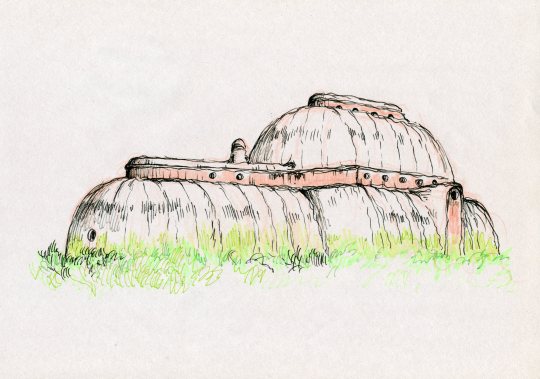





A few sketches done over the past several days, going over some possibilities for a commissioned piece. Most of the finished work I've done lately has kind of subordinated the architectural elements, so it's been good to reorient my focus. I really enjoy this kind of "exquisite corpse" method of composition; it never stops being exciting to contrast the vernacular with the formal, and seeing what monstrous oddities emerge onto the page.
#architecture#organic architecture#ink drawing#capriccio#fantasy architecture#barn#vernacular architecture#classical architecture#shingle style#exquisite corpse#sketch
26 notes
·
View notes